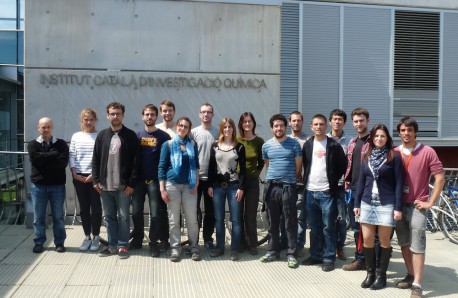Llobet
Research group

RESEARCH ABSTRACT
The group carries out research in the field of redox catalysis using transition metal complexes. We are interested in the oxidation and reduction of both organic and inorganic substrates, and mainly those that are of technological interest. Our overall objective is to understand the various factors that affect catalyst’s efficiency and selectivity with special focus on the transition metal electronic structure and space disposition.
Particular attention is being paid to the catalytic oxidation of water to molecular dioxygen, given the implications of this reaction for new energy conversion schemes based on artificial photosynthesis. The final objective of this route consists on the photo-production of hydrogen from water and sunlight.
Topics addressed
- Catalysis for artificial photosynthesis
- Photochemical oxidation of organic substrates
- Suparamolecular catalysis
Articles
“Carbon Dioxide Reduction Catalyzed by Dinuclear Ruthenium Polypyridyl Complexes”
ChemCatChem.(2013) 5(12), 3897-3903
T. Ono, N. Planas, P. Miró, M. Z. Ertem, E. C. Escudero-Adán, J. Benet-Buchholz, L. Gagliardi, C. J. Cramer, A. Llobet
“Ruthenium Complexes with Chiral Bis-Pinene Ligands: an Array of Subtle Structural Diversity”
Inorg. Chem. (2013) 52(9), 4985-4992
L. Vaquer, A. Poater, J. De Tovar, J. Garcia-Anton, M. Sola, A. Llobet, X. Sala
“New Dinuclear Ruthenium Complexes: Structure and Oxidative Catalysis”
Inorg. Chem. (2013) 52(8), 4335-4345
C. Di Giovanni, L. Vaquer, X. Sala, J. Benet-Buchholz, A. Llobet
“Mononuclear ruthenium-water oxidation catalysts: Discerning between electronic and hydrogen-bonding effects”
Inorg. Chem. (2013) 52(7), 3591-3593
S. Maji, I. López, F. Bozoglian, J. Benet-Buchholz, A. Llobet
“Molecular ruthenium complexes anchored on magnetic nanoparticles that act as powerful and magnetically recyclable stereospecific epoxidation catalysts”
Catal. Sci. Technol. (2013) 3, 706-714
L. Vaquer, P. Riente, X. Sala, S. Jansat, J. Benet-Buchholz, A. Llobet, M. A. Pericàs
“Synthesis, characterization, reactivity, and linkage isomerization of Ru(Cl)2(L)(DMSO)2 complexes”
Eur. J. Inorg. Chem. (2013) 31, 232-240
S. Roeser, S. Maji, J. Benet-Buchholz, J. Pons, A. Llobet
“Synthesis, Characterization, and Reactivity of Dyad Ruthenium-Based Molecules for Light-Driven Oxidation Catalysis”
Chem. Eur. J. (2013) 19(22), 7162–7172
P. Farràs, S. Maji, J. Benet-Buchholz, A. Llobet
“Understanding Electronic Ligand Perturbation over Successive Metal-Based Redox Potentials in Mononuclear Ruthenium–Aqua Complexes”
(2013) 78(3), 235-243
L. Vaquer, P. Miró, X. Sala, F. Bozoglian, E. Masllorens, J. Benet-Buchholz, X. Fontrodona, T. Parella, I. Romero, A. Roglans, M. Rodríguez, C. Bo, A. Llobet
“Artificial Photosynthesis for Solar Fuels – an Evolving Research Field within AMPEA, a Joint Programme of the European Energy Research”
Alliance. Green.(2013) 3(1), 43 – 57
A. Thapper; S. Styring; G. Saracco; A.W. Rutherford; B. Robert; A. Magnuson; W. Lubitz; A. Llobet; P. Kurz; A. Holzwarth; S. Fiechter; H. de Groot; S. Campagna; A. Braun; H. Bercegol; V. Artero.
“Protonation Equilibrium and Hydrogen Production by a Dinuclear Cobalt-μ-Hydride Complex Reduced by Cobaltocene with Trifluoroacetic Acid”
J. Am. Chem. Soc.(2013) 135(41),15294 – 15297
S. Mandal; S. Shikano; Y. Yamada; Y.-M. Lee; W. Nam; A. Llobet; S. Fukuzumi
“Simple and cheap steric and electronic characterization of the reactivity of Ru(II) complexes containing oxazoline ligands as epoxidation catalysts”
Chem. Phys. Let.(2013) 577, 142 – 146
A. Poater; L. Falivene; L. Cavallo; A. Llobet; M. Rodríguez; I. Romero; M. Sola
“Synthesis, Electronic Structure and Magnetism of [Ni(6-Mes)2 ]+: A Two-Coordinate Nickel(I) Complex Stabilized by Bulky N-Heterocyclic Carbenes.”
J. Am. Chem. Soc.(2013) 135( 37),13640 – 13643
R.C. Poulten; M.J. Page; A.G. Algarra; J.J. Le Roy; I. López; E. Carter; A. Llobet; S.A. Macgregor; M.F. Mahon;D.M. Murphy; M. Murugesu; M.K. Whittlesey
“Water oxidation catalysis with nonheme iron complexes under acidic and basic conditions: homogeneous or heterogeneous”
Inorg. Chem. (2013) 52(16), 9522 – 9531
D. Hong; S. Mandal; Y. Yamada; Y.-L. Lee; W. Nam; A. Llobet; S. Fukuzumi